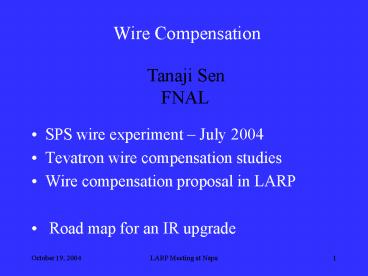Wire Compensation PowerPoint PPT Presentation
1 / 21
Title: Wire Compensation
1
Wire Compensation
Tanaji Sen FNAL
- SPS wire experiment July 2004
- Tevatron wire compensation studies
- Wire compensation proposal in LARP
- Road map for an IR upgrade
2
New Wires installed in 2004
3 wires (60cm long) in each unit Only bottom wire
was powered Beam pipe on vertically movable
stands (movable by 5mm)
3
SPS beam conditions
- Energy 26 GeV
- Intensity 4E12 in 12 bunches
- SPS cycle 4.5 seconds
- Wire excitation
- - powered on at 0.5 secs
- - full current at 1.0 secs
- (max current 270A)
- - ramped down at 4.0 secs
- Orbit changes and tune shifts due to wire
- were compensated.
4
Position sensitivityprediction measurement
BBSIM No compensation beyond 3mm Measurement
Compensation lost beyond 2.5mm from optimum
5
SPS wire compensation
Emittance shaving occurs early
Intensity Loss compensated By 2nd wire
6
SPS experiment tune scan
tune scan with compensation of 2 BBLRs in the
CERN SPS near the LHC working point
30.07.04
no BBLR
path in the tune diagram
compensation
F. Zimmermann
1 BBLR
nearly perfect compensation
?
7
Tevatron wire compensation study
- Compensation at injection
- Compensation at collision
- Local compensation of parasitics
- Non-local compensation of parasitics
- Wires with elliptic cross-section
- Multiple wires
8
Beam separations in the Tevatron
Experiments at B0 and D0
Beam separations at parasitics around B0 and D0
are 5sigma Beta functions are large in one
plane beams are very elliptical at these
locations
9
Contributions of parasitics
Parasitics around B0 and D0 contribute largest
tune shifts
Several parasitics around the ring cause
comparable diffusion
10
Fields of round elliptical beams
Difference in kicks between a round beam and a
wire. Less than 1 beyond 3 sigma
Difference between elliptical beams and a wire.
Round
11
Non-local compensation
Conditions for compensation of 1 beam-beam kick
Compensation of several beam- beam kicks by a
wire can only be done in an average sense.
12
Local non-local compensation
Round beams at 9 sigma Wire reduces diffusion
Compensation of parasitics near B0 and D0. Wires
placed at appropriate phase advances. Wires do
not help.
13
Elliptical Wires
- Round wires are not well matched to the field of
very elliptical beams. - Wire with elliptical cross-section is better
suited. - Field of the wire matches that of the beam to
better than 2 outside the core. - Could be tested in simulations.
14
Multiple Wires
- Could adapt to changes in helix
- Field of strong beam could be better matched
across width of weak beam - Multiple resonances could be compensated
- Issues
- Robustness
- Impact on strong beam
- ..
15
Wire Compensation Proposal
Proponents FNAL Tanaji Sen, Vladimir
Shiltsev BNL Wolfram Fischer LBNL Miguel
Furman, Ji Qiang CERN Jean-Pierre Koutchouk,
Jorg Wenninger, Frank Zimmermann
16
Wire compensation proposal
- Experimental demonstration of the principle in
the SPS with one wire simulating the beam and the
second as the compensator - Experimental demonstration in a hadron collider
(RHIC or Tevatron) or lepton collider (e.g.
PEP-II) - demonstrate use of the wire for the
benefit of this collider, e.g, as scraper, or for
future upgrades. - RHIC - compensation of long-range collisions in
eRHIC or after IR upgrades - Tevatron - improving performance of Run-II /
BTeV - RD on pulsed wire compensation system possible
test of pulsed wire on beam in existing machine - Design of compensation device for LHC assuming
success of former points.
17
Wire Compensation in LARP
- SPS 2004, 4 BBLR machine studies generated a
lot of data - - a partial involvement of a scientist and
of a fellow in the analysis - - would benefit from assistance by computer
scientists - - use as a test bed for information sharing
as a preparation to remote participation in
machine studies for the sharing of data and
analysis procedures and results - 2) Experimental full-size demonstration
- - which existing collider is most suitable
for creating the nominal LHC long-range beam-beam
conditions - - refit the SPS devices or build new ones
and carry through an - experimental study program
- 3) Pulsed wire RD in collaboration with CERN
- (typically a few hundred Amperes pulsed at a
few MHz or, alternatively, - at 40 MHz).
- LHC implementation design of a movable wire
compensator suitable for LHC
18
Different IR Layouts
19
IR upgrade small x-angles
Design Paths
Quads First
Dipoles First
Wire compensation
Energy Deposition
Design cos ?, block coil
Optics
Dynamic Aperture
Matching
Correctors
20
IR upgrade large x-angles
Design Paths
High Intensity Beam-beam limit
Nominal Intensity Crab cavities
- Requires large cavity voltage
- Emittance blow-up possible
1500 long bunches
Superbunches
- Huge pile-up
- May be ruled
- out by CMS,
- ATLAS
- Pile-up still
- large
- Intensities
- may be limited
21
IR upgrade road map for LARP
Wire compensation
You are here
Correctors Field quality
Quads First
Matched Design
GOAL Optics design to provide input for Magnet
RD Not to create an optimized
design for the LHC

